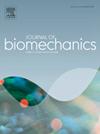Mechanical and biological characteristics of 3D-printed auxetic structure in bone tissue engineering
IF 2.4
3区 医学
Q3 BIOPHYSICS
引用次数: 0
Abstract
The auxetic structures are highly effective in bone implants due to their unique deformation characteristics. However, ideal tissue engineering scaffolds must possess suitable mechanical properties and biocompatibility. The biological effects of auxetic structures require further study. In this study, three types of 3D re-entrant honeycomb structures with varying angles of 75°, 90°, and 105° were designed. These structures were fabricated by stereolithography 3D printing technology. Finite element simulations and compression tests were conducted to evaluate their mechanical properties. Scaffolds were inoculated with preosteoblast MC3T3-E1 cells, and cyclic loading was applied to investigate the influence of structural and mechanical stimulation on cell arrangement and proliferation. The results demonstrated that the 75° scaffold exhibited auxetic characteristics in all compression directions and possessed anti-fracture properties. The 75° scaffold also promoted cell proliferation by structural design. Cyclic compression facilitated the nuclear translocation of YAP, further enhancing cell growth. The combination of anti-fracture properties and the promotion of cell proliferation makes auxetic structures highly promising for extensive applications.
三维打印辅助结构在骨组织工程中的力学和生物学特性
本文章由计算机程序翻译,如有差异,请以英文原文为准。
求助全文
约1分钟内获得全文
求助全文
来源期刊

Journal of biomechanics
生物-工程:生物医学
CiteScore
5.10
自引率
4.20%
发文量
345
审稿时长
1 months
期刊介绍:
The Journal of Biomechanics publishes reports of original and substantial findings using the principles of mechanics to explore biological problems. Analytical, as well as experimental papers may be submitted, and the journal accepts original articles, surveys and perspective articles (usually by Editorial invitation only), book reviews and letters to the Editor. The criteria for acceptance of manuscripts include excellence, novelty, significance, clarity, conciseness and interest to the readership.
Papers published in the journal may cover a wide range of topics in biomechanics, including, but not limited to:
-Fundamental Topics - Biomechanics of the musculoskeletal, cardiovascular, and respiratory systems, mechanics of hard and soft tissues, biofluid mechanics, mechanics of prostheses and implant-tissue interfaces, mechanics of cells.
-Cardiovascular and Respiratory Biomechanics - Mechanics of blood-flow, air-flow, mechanics of the soft tissues, flow-tissue or flow-prosthesis interactions.
-Cell Biomechanics - Biomechanic analyses of cells, membranes and sub-cellular structures; the relationship of the mechanical environment to cell and tissue response.
-Dental Biomechanics - Design and analysis of dental tissues and prostheses, mechanics of chewing.
-Functional Tissue Engineering - The role of biomechanical factors in engineered tissue replacements and regenerative medicine.
-Injury Biomechanics - Mechanics of impact and trauma, dynamics of man-machine interaction.
-Molecular Biomechanics - Mechanical analyses of biomolecules.
-Orthopedic Biomechanics - Mechanics of fracture and fracture fixation, mechanics of implants and implant fixation, mechanics of bones and joints, wear of natural and artificial joints.
-Rehabilitation Biomechanics - Analyses of gait, mechanics of prosthetics and orthotics.
-Sports Biomechanics - Mechanical analyses of sports performance.
 求助内容:
求助内容: 应助结果提醒方式:
应助结果提醒方式:


